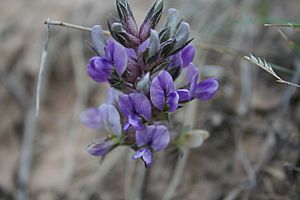Psoralea esculenta facts for kids
Quick facts for kids Psoralea esculenta |
|
|---|---|
 |
|
| In bloom in Badlands National Park, South Dakota | |
| Scientific classification | |
| Kingdom: | |
| (unranked): | |
| (unranked): | |
| (unranked): | |
| Order: | |
| Family: | |
| Genus: |
Psoralea
|
| Species: |
P. esculenta
|
| Binomial name | |
| Psoralea esculenta Pursh
|
|
| Synonyms | |
|
Pediomelum esculentum (Pursh) Rydb. |
|
The prairie turnip (scientific name: Psoralea esculenta), also known as timpsula, is a special plant found in the prairies and dry woodlands of central North America. It's a perennial plant, meaning it lives for more than two years. This plant is famous for its starchy, potato-like root, which is totally edible! People also call it tipsin, breadroot, or pomme blanche. For the Plains Indians, the prairie turnip was a very important food.
Another plant, Psoralea hypogaea, is called the little breadroot. It's also edible, but smaller.
Contents
About the Prairie Turnip
The prairie turnip grows across the Great Plains. You can find it from Manitoba in Canada all the way south to Texas. It also grows from Wisconsin west to Montana. This plant loves sunny spots with soil that drains well, like rocky or sandy ground.
What the Plant Looks Like
The prairie turnip is a perennial, which means it lives for 3 to more than 6 years. In spring, several hairy stems grow from the ground. They can reach up to 30 cm (about 1 foot) tall. Each stem has leaves that look like a hand with five leaflets.
In early summer, the plant shows off beautiful blue or purple flowers. These flowers grow in clusters at the top of the stems. Each cluster is about 5 to 10 cm (2 to 4 inches) long. After flowering, the plant makes flat, slender pods.
The Edible Root
The most important part of the prairie turnip is its root. These roots are sturdy and brown. They form rounded, spindle-shaped tubers about 7 to 10 cm (3 to 4 inches) below the ground. Each tuber is usually 4 to 10 cm (1.5 to 4 inches) long. These tubers are what people eat!
Where the Name Comes From
The Lakota name for this plant is Timpsula. The city of Topeka, the capital of Kansas, might even be named after this plant! It's believed that "Topeka" means "a good place to dig prairie turnips" in the Kansa and other Siouan languages.
Harvesting Prairie Turnips
The prairie turnip was a very important food for the Plains Indians. It was easy to find in good conditions, tasted good, and was full of nutrients. Early European explorers also relied on it.
When and How to Harvest
People usually harvested the roots from May through July. This was when the bright flower stalks were easy to spot among the prairie grasses. Native American women often harvested the roots. They used a sharpened stick, hardened by fire, to dig them up.
Preparing and Storing the Roots
The tubers have a tough, dark skin. This skin needs to be peeled off before you eat them. Some roots were eaten right away, either raw or boiled. But most were dried to save for later.
To dry them, people would:
- Slice the roots and dry them in the sun.
- Braid them together and hang them on meat racks to dry.
- Pound them into a flour.
The prairie turnip was also a lifesaver during times when food was scarce. Many stories tell of Native Americans and early settlers surviving on these roots when other food wasn't available.
Nutritional Value
The prairie turnip is very healthy! It's more nutritious than many other root vegetables. It has about 7 percent protein and more than 50 percent carbohydrates. It's also rich in important vitamins and minerals. One key nutrient is vitamin C, with about 17.1 milligrams per 100 grams. This was especially important for the Plains Indians, whose winter diet of meat often lacked vitamin C.
It takes 2 to 4 years for a prairie turnip to grow from a seed to a full-sized root. Because it takes so long, it was hard for Native Americans to grow it like a farm crop. Scientists today are studying it to see if it could be grown more easily.
How Prairie Turnips Were Used as Food
People have different opinions on how the prairie turnip tastes. Some say it's a "delicacy," while others find it "tasteless."
Native Americans used it in many ways:
- They ate it uncooked.
- They boiled it.
- They roasted it in hot embers.
- They dried it and ground it into powder to make soup.
Large amounts of dried roots were stored in buffalo skin bags for winter. A popular dish was a pudding made from the root flour mixed with saskatoon berries.
Today, the peeled root can be eaten raw or cooked. The dried root can still be ground into flour. Prairie turnip flour is sometimes used as a "secret ingredient" in modern Indian frybread recipes.


